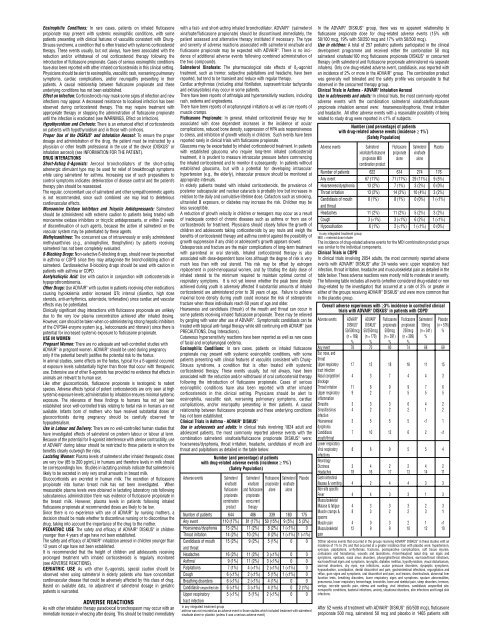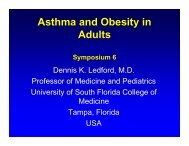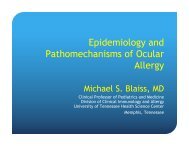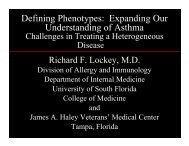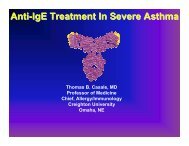scientific program - World Allergy Organization
scientific program - World Allergy Organization
scientific program - World Allergy Organization
Create successful ePaper yourself
Turn your PDF publications into a flip-book with our unique Google optimized e-Paper software.
Eosinophilic Conditions: In rare cases, patients on inhaled fluticasone<br />
propionate may present with systemic eosinophilic conditions, with some<br />
patients presenting with clinical features of vasculitis consistent with Churg-<br />
Strauss syndrome, a condition that is often treated with systemic corticosteroid<br />
therapy. These events usually, but not always, have been associated with the<br />
reduction and/or withdrawal of oral corticosteroid therapy following the<br />
introduction of fluticasone propionate. Cases of serious eosinophilic conditions<br />
have also been reported with other inhaled corticosteroids in this clinical setting.<br />
Physicians should be alert to eosinophilia, vasculitic rash, worsening pulmonary<br />
symptoms, cardiac complications, and/or neuropathy presenting in their<br />
patients. A causal relationship between fluticasone propionate and these<br />
underlying conditions has not been established.<br />
Effect on Infection: Corticosteroids may mask some signs of infection and new<br />
infections may appear. A decreased resistance to localised infection has been<br />
observed during corticosteroid therapy. This may require treatment with<br />
appropriate therapy or stopping the administration of fluticasone propionate<br />
until the infection is eradicated (see WARNINGS, Effect on Infection).<br />
Hypothyroidism and Cirrhosis: There is an enhanced effect of corticosteroids<br />
on patients with hypothyroidism and in those with cirrhosis.<br />
Proper Use of the DISKUS ®<br />
and Inhalation Aerosol: To ensure the proper<br />
dosage and administration of the drug, the patient must be instructed by a<br />
physician or other health professional in the use of the device (DISKUS ®<br />
or<br />
inhalation aerosol) (see INFORMATION FOR THE PATIENT).<br />
DRUG INTERACTIONS<br />
Short-Actingß-Agonists: Aerosol bronchodilators of the short-acting<br />
adrenergic stimulant type may be used for relief of breakthrough symptoms<br />
while using salmeterol for asthma. Increasing use of such preparations to<br />
control symptoms indicates deterioration of disease control and the patient’s<br />
therapy plan should be reassessed.<br />
The regular, concomitant use of salmeterol and other sympathomimetic agents<br />
is not recommended, since such combined use may lead to deleterious<br />
cardiovascular effects.<br />
Monoamine Oxidase Inhibitors and Tricyclic Antidepressants: Salmeterol<br />
should be administered with extreme caution to patients being treated with<br />
monoamine oxidase inhibitors or tricyclic antidepressants, or within 2 weeks<br />
of discontinuation of such agents, because the action of salmeterol on the<br />
vascular system may be potentiated by these agents.<br />
Methylxanthines: The concurrent use of intravenously or orally administered<br />
methylxanthines (e.g., aminophylline, theophylline) by patients receiving<br />
salmeterol has not been completely evaluated.<br />
ß-Blocking Drugs: Non-selective ß-blocking drugs, should never be prescribed<br />
in asthma or COPD since they may antagonise the bronchodilating action of<br />
salmeterol. Cardioselective ß-blocking drugs should be used with caution in<br />
patients with asthma or COPD.<br />
Acetylsalicylic Acid: Use with caution in conjunction with corticosteroids in<br />
hypoprothrombinemia.<br />
Other Drugs: Use ADVAIR ®<br />
with caution in patients receiving other medications<br />
causing hypokalemia and/or increased QTc interval (diuretics, high dose<br />
steroids, anti-arrhythmics, astemizole, terfenadine) since cardiac and vascular<br />
effects may be potentiated.<br />
Clinically significant drug interactions with fluticasone propionate are unlikely<br />
due to the very low plasma concentration achieved after inhaled dosing.<br />
However, care should be taken when co-administering strong hepatic inhibitors<br />
of the CYP3A4 enzyme system (e.g., ketoconazole and ritonavir) since there is<br />
potential for increased systemic exposure to fluticasone propionate.<br />
USE IN WOMEN<br />
Pregnant Women: There are no adequate and well-controlled studies with<br />
ADVAIR ®<br />
in pregnant women. ADVAIR ®<br />
should be used during pregnancy<br />
only if the potential benefit justifies the potential risk to the foetus.<br />
In animal studies, some effects on the foetus, typical for a ß-agonist occurred<br />
at exposure levels substantially higher than those that occur with therapeutic<br />
use. Extensive use of other ß-agonists has provided no evidence that effects in<br />
animals are relevant to human use.<br />
Like other glucocorticoids, fluticasone propionate is teratogenic to rodent<br />
species. Adverse effects typical of potent corticosteroids are only seen at high<br />
systemic exposure levels; administration by inhalation ensures minimal systemic<br />
exposure. The relevance of these findings to humans has not yet been<br />
established since well-controlled trials relating to foetal risk in humans are not<br />
available. Infants born of mothers who have received substantial doses of<br />
glucocorticoids during pregnancy should be carefully observed for<br />
hypoadrenalism.<br />
Use in Labour and Delivery: There are no well-controlled human studies that<br />
have investigated effects of salmeterol on preterm labour or labour at term.<br />
Because of the potential for ß-agonist interference with uterine contractility, use<br />
of ADVAIR ®<br />
during labour should be restricted to those patients in whom the<br />
benefits clearly outweigh the risks.<br />
Lactating Women: Plasma levels of salmeterol after inhaled therapeutic doses<br />
are very low (85 to 200 pg/mL) in humans and therefore levels in milk should<br />
be correspondingly low. Studies in lactating animals indicate that salmeterol is<br />
likely to be secreted in only very small amounts in breast milk.<br />
Glucocorticoids are excreted in human milk. The excretion of fluticasone<br />
propionate into human breast milk has not been investigated. When<br />
measurable plasma levels were obtained in lactating laboratory rats following<br />
subcutaneous administration there was evidence of fluticasone propionate in<br />
the breast milk. However, plasma levels in patients following inhaled<br />
fluticasone propionate at recommended doses are likely to be low.<br />
Since there is no experience with use of ADVAIR ®<br />
by nursing mothers, a<br />
decision should be made whether to discontinue nursing or to discontinue the<br />
drug, taking into account the importance of the drug to the mother.<br />
PEDIATRIC USE The safety and efficacy of ADVAIR ®<br />
DISKUS ®<br />
in children<br />
younger than 4 years of age have not been established.<br />
The safety and efficacy of ADVAIR ®<br />
inhalation aerosol in children younger than<br />
12 years of age have not been established.<br />
It is recommended that the height of children and adolescents receiving<br />
prolonged treatment with inhaled corticosteroids is regularly monitored<br />
(see ADVERSE REACTIONS).<br />
GERIATRIC USE As with other ß2-agonists, special caution should be<br />
observed when using salmeterol in elderly patients who have concomitant<br />
cardiovascular disease that could be adversely affected by this class of drug.<br />
Based on available data, no adjustment of salmeterol dosage in geriatric<br />
patients is warranted.<br />
ADVERSE REACTIONS<br />
As with other inhalation therapy paradoxical bronchospasm may occur with an<br />
immediate increase in wheezing after dosing. This should be treated immediately<br />
with a fast- and short-acting inhaled bronchodilator. ADVAIR ®<br />
(salmeterol<br />
xinafoate/fluticasone propionate) should be discontinued immediately, the<br />
patient assessed and alternative therapy instituted if necessary. The type<br />
and severity of adverse reactions associated with salmeterol xinafoate and<br />
fluticasone propionate may be expected with ADVAIR ®<br />
. There is no incidence<br />
of additional adverse events following combined administration of<br />
the two compounds.<br />
Salmeterol Xinafoate: The pharmacological side effects of ß2-agonist treatment, such as tremor, subjective palpitations and headache, have been<br />
reported, but tend to be transient and reduce with regular therapy.<br />
Cardiac arrhythmias (including atrial fibrillation, supraventricular tachycardia<br />
and extrasystoles) may occur in some patients.<br />
There have been reports of arthralgia and hypersensitivity reactions, including<br />
rash, oedema and angioedema.<br />
There have been reports of oropharyngeal irritations as well as rare reports of<br />
muscle cramps.<br />
Fluticasone Propionate: In general, inhaled corticosteroid therapy may be<br />
associated with dose dependent increases in the incidence of ocular<br />
complications, reduced bone density, suppression of HPA axis responsiveness<br />
to stress, and inhibition of growth velocity in children. Such events have been<br />
reported rarely in clinical trials with fluticasone propionate.<br />
Glaucoma may be exacerbated by inhaled corticosteroid treatment. In patients<br />
with established glaucoma who require long-term inhaled corticosteroid<br />
treatment, it is prudent to measure intraocular pressure before commencing<br />
the inhaled corticosteroid and to monitor it subsequently. In patients without<br />
established glaucoma, but with a potential for developing intraocular<br />
hypertension (e.g., the elderly), intraocular pressure should be monitored at<br />
appropriate intervals.<br />
In elderly patients treated with inhaled corticosteroids, the prevalence of<br />
posterior subcapsular and nuclear cataracts is probably low but increases in<br />
relation to the daily and cumulative lifetime dose. Cofactors such as smoking,<br />
ultraviolet B exposure, or diabetes may increase the risk. Children may be<br />
less susceptible.<br />
A reduction of growth velocity in children or teenagers may occur as a result<br />
of inadequate control of chronic diseases such as asthma or from use of<br />
corticosteroids for treatment. Physicians should closely follow the growth of<br />
children and adolescents taking corticosteroids by any route and weigh the<br />
benefits of corticosteroid therapy and asthma control against the possibility of<br />
growth suppression if any child or adolescent’s growth appears slowed.<br />
Osteoporosis and fracture are the major complications of long-term treatment<br />
with parenteral or oral steroids. Inhaled corticosteroid therapy is also<br />
associated with dose-dependent bone loss although the degree of risk is very<br />
much less than with oral steroid. This risk may be offset by estrogen<br />
replacement in post-menopausal women, and by titrating the daily dose of<br />
inhaled steroid to the minimum required to maintain optimal control of<br />
respiratory symptoms. It is not yet known whether the peak bone density<br />
achieved during youth is adversely affected if substantial amounts of inhaled<br />
corticosteroid are administered prior to 30 years of age. Failure to achieve<br />
maximal bone density during youth could increase the risk of osteoporotic<br />
fracture when those individuals reach 60 years of age and older.<br />
Hoarseness and candidiasis (thrush) of the mouth and throat can occur in<br />
some patients receiving inhaled fluticasone propionate. These may be relieved<br />
by gargling with water after use of ADVAIR ®<br />
. Symptomatic candidiasis can be<br />
treated with topical anti-fungal therapy while still continuing with ADVAIR ®<br />
(see<br />
PRECAUTIONS, Drug Interactions).<br />
Cutaneous hypersensitivity reactions have been reported as well as rare cases<br />
of facial and oropharyngeal oedema.<br />
Eosinophilic Conditions: In rare cases, patients on inhaled fluticasone<br />
propionate may present with systemic eosinophilic conditions, with some<br />
patients presenting with clinical features of vasculitis consistent with Churg-<br />
Strauss syndrome, a condition that is often treated with systemic<br />
corticosteroid therapy. These events usually, but not always, have been<br />
associated with the reduction and/or withdrawal of oral corticosteroid therapy<br />
following the introduction of fluticasone propionate. Cases of serious<br />
eosinophilic conditions have also been reported with other inhaled<br />
corticosteroids in this clinical setting. Physicians should be alert to<br />
eosinophilia, vasculitic rash, worsening pulmonary symptoms, cardiac<br />
complications, and/or neuropathy presenting in their patients. A causal<br />
relationship between fluticasone propionate and these underlying conditions<br />
has not been established.<br />
Clinical Trials in Asthma - ADVAIR ®<br />
DISKUS ®<br />
Use in adolescents and adults: In clinical trials involving 1824 adult and<br />
adolescent patients, the most commonly reported adverse events with the<br />
combination salmeterol xinafoate/fluticasone propionate DISKUS ®<br />
were:<br />
hoarseness/dysphonia, throat irritation, headache, candidiasis of mouth and<br />
throat and palpitations as detailed in the table below:<br />
Number (and percentage) of patients<br />
with drug-related adverse events (incidence ≥ 1% 1<br />
)<br />
(Safety Population)<br />
Adverse events Salmeterol Salmeterol Fluticasone Salmeterol Placebo<br />
xinafoate/ xinafoate propionate xinafoate<br />
fluticasone and fluticasone alone alone<br />
propionate propionate<br />
Number of patients<br />
Any event<br />
combination<br />
product<br />
644<br />
110 (17%)<br />
concurrent<br />
therapy<br />
486<br />
81 (17%)<br />
339<br />
50 (15%)<br />
180<br />
9 (5%)<br />
175<br />
5 (3%)<br />
Hoarseness/dysphonia 15 (2%) 11 (2%) 8 (2%) 1 (


